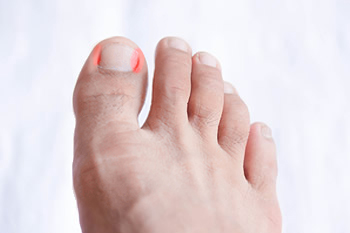Houston
Pearland
 The medical name for an ingrown toenail is known as onychocryptosis. This can happen as a result of the side of the toenail growing into the skin, and can cause severe pain and discomfort. Additional symptoms may include discharge draining from the affected area, and the side of the toe may appear swollen. A common reason an ingrown toenail may develop can be from shoes worn that do not have adequate room for the toes to move freely in. Trimming your toenails incorrectly may also cause an ingrown toenail. It is beneficial for the nails be trimmed straight across, and not too short. If you notice you have an ingrown toenail, it is advised that you are treated by a podiatrist who can help you to prevent an infection from occurring.
The medical name for an ingrown toenail is known as onychocryptosis. This can happen as a result of the side of the toenail growing into the skin, and can cause severe pain and discomfort. Additional symptoms may include discharge draining from the affected area, and the side of the toe may appear swollen. A common reason an ingrown toenail may develop can be from shoes worn that do not have adequate room for the toes to move freely in. Trimming your toenails incorrectly may also cause an ingrown toenail. It is beneficial for the nails be trimmed straight across, and not too short. If you notice you have an ingrown toenail, it is advised that you are treated by a podiatrist who can help you to prevent an infection from occurring.
Ingrown toenails can become painful if they are not treated properly. For more information about ingrown toenails, contact Dr. Linda D. Nachmani of Central Foot & Ankle Associates. Our doctor can provide the care you need to keep you pain-free and on your feet.
Ingrown Toenails
Ingrown toenails occur when a toenail grows sideways into the bed of the nail, causing pain, swelling, and possibly infection.
Causes
Prevention
Because ingrown toenails are not something found outside of shoe-wearing cultures, going barefoot as often as possible will decrease the likeliness of developing ingrown toenails. Wearing proper fitting shoes and using proper cutting techniques will also help decrease your risk of developing ingrown toenails.
Treatment
Ingrown toenails are a very treatable foot condition. In minor cases, soaking the affected area in salt or antibacterial soaps will not only help with the ingrown nail itself, but also help prevent any infections from occurring. In more severe cases, surgery is an option. In either case, speaking to your podiatrist about this condition will help you get a better understanding of specific treatment options that are right for you.
If you have any questions please feel free to contact one of our offices located in Houston, and Pearland, TX. We offer the newest diagnostic and treatment technologies for all your foot and ankle needs.
Read more about Ingrown Toenail Care